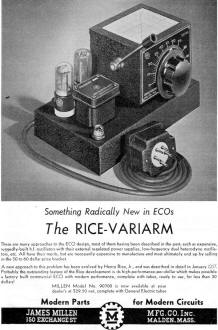February 1941 QST
 Table
of Contents Table
of Contents
Wax nostalgic about and learn from the history of early electronics. See articles
from
QST, published December 1915 - present (visit ARRL
for info). All copyrights hereby acknowledged.
|
Electron-coupled oscillators (ECOs) were a real breakthrough in achieving frequency stability
in harsh environments that included mechanical vibration, temperature excursions,
power supply variations, and load changes. Use of vacuum tubes made the task even
more challenging. Such oscillators were necessarily very expensive compared to less
sophisticated designs. Henry E. Rice Jr., W9YZH, introduced his "Rice Variarm" model
(aka the Millen Model 90700) at a breakthrough price of just $29.50, which in 2023
money equates to $635 per the U.S. BLS
Inflation Calculator. That is a lot of moola for amateur radio
operators even today. The arm sticking out of the case is for adjusting the frequency
- hence, the Variarm.
The Rice-Variarm

Something Radically New in ECOs
There are many approaches to the ECO design, most of them having been described
in the past; such as expensive, ruggedly-built h.f. oscillators with their external
regulated power supplies, low-frequency dual heterodyne oscillators, etc. All have
their merits, but are necessarily expensive to manufacture and must ultimately end
up by selling in the 50 to 60 dollar price bracket.
A new approach to this problem has been evolved by Henry Rice, Jr., and was described
in detail in January OST. Probably the outstanding feature of the Rice development
is its high-performance-per-dollar which makes possible a factory built commercial
ECO with modern performance, complete with tubes, ready to use, for less than 30
dollars!
Posted June 28, 2023
(updated from original post
on 11/6//2013)
|










